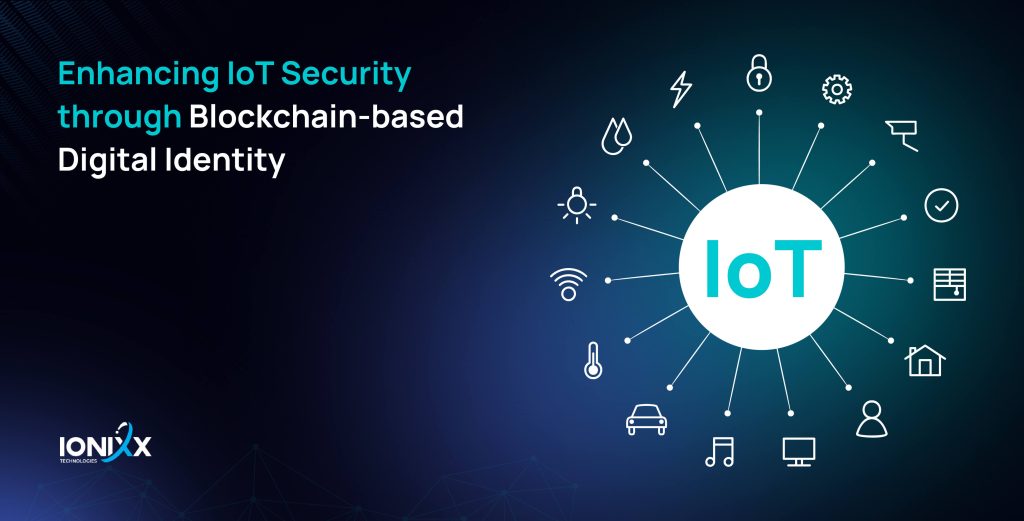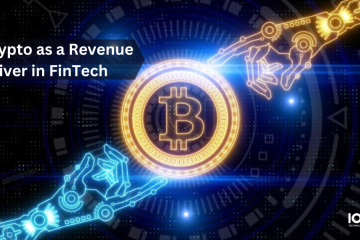Enhancing IoT Security through Blockchain-based Digital Identity

A recent forecast from International Data Corporation (IDC) estimates that there will be 41.6 billion connected IoT devices, or “things,” generating 79.4 zettabytes (ZB) of data in 2025.
The growing proliferation of connected devices is an encouraging trend in the digital age. However, it also presents a paradox. Constant exchange of data and subsequent information exchanges in a connected digital ecosystem can open up avenues for security vulnerabilities. The Miraibot is a case in point. A blockchain-based digital ID can help address these security vulnerabilities.
In this blog, we discuss how blockchain-based digital ID can serve as a useful alternative to traditional security systems that currently underscore IoT devices. We discuss blockchain implementation challenges for IoT systems while understanding the emerging field of the Blockchain of Things (BoT) with real-life use cases.
IoT: A Nexus of Threat and Opportunity
Currently, IoT centers with inherent identity and authority systems lack a universal means to distinguish a thing from all others or determine what that thing is allowed to do. This is because traditional security systems often fall short when safeguarding digital identities and IoT networks. With increasing instances of data breaches, hacks, and identity theft, a more secure framework is urgently required.
Security Vulnerabilities: The Achilles’ Heel of IoT Systems
IoT devices, with their vast interconnectivity, dramatically increase the attack surface for cybercriminals. Centralized storage of credentials, weak authentication, and software vulnerabilities pose significant threats to the security of digital IDs. For instance, in 2016, the infamous Mirai botnet attack exploited default factory passwords in IoT devices, wreaking havoc across the globe. This incident underlines the pressing need for robust security measures that authenticate, encrypt, and safeguard digital IDs effectively.
Centralized Access Management: An Orchestrated Meltdown Waiting to Happen
Traditional centralized access management systems struggle to cope with the magnitude and dynamics of the IoT landscape. The sheer number of devices, along with frequent connections and disconnections, exacerbates the challenge. It’s like controlling a bustling city’s traffic with just a single traffic light – a recipe for congestion and chaos. The lack of efficient device provisioning and de-provisioning mechanisms can lead to unauthorized access or the spread of compromised identities. Developing decentralized access management frameworks that distribute identity management across various layers can enhance security and resilience.
Lack of a Standard Security Framework: The Wild West of IoT Digital ID
IoT devices are susceptible to hacking, data breaches, and other malicious activities given how they aren’t governed by a unified security framework. Forbes reports that in 2019 alone, there were over 11 billion IoT device attacks. Clearly, traditional security approaches are insufficient, highlighting the urgent need for innovative solutions such as blockchain-based digital identity. Protection In the absence of a standardized security framework for IoT devices, manufacturers often prioritize functionality over robust security measures. This fragmented ecosystem leaves valuable digital identities vulnerable to exploitation. It resembles a scenario where every home builder invents their own house-locking mechanism, with varying levels of effectiveness and reliability. Adopting a universal security framework, such as the IoT Security Foundation’s Framework, would ensure consistent security practices throughout the IoT ecosystem.
Privacy Concerns: Safeguarding Data Beyond the Surface
IoT systems generate massive amounts of sensitive data, raising significant privacy concerns. Unauthorized access to personal information or devices becomes a gateway to intrusive surveillance, profiling, or even physical threats. Take the case of smart home devices, which record and analyze our daily routines. If mishandled, this data can reveal intimate details of our lives. To mitigate privacy risks, IoT systems should implement privacy-by-design principles, enforced through techniques like pseudonymization, encryption, and user consent frameworks.
Scalability Challenges
IoT systems are expanding at an unprecedented rate, encompassing a plethora of devices with unique digital identities. Managing this exponential growth requires efficient scalability mechanisms. Imagine a rapidly growing metropolis with an outdated transportation network incapable of accommodating new residents – chaos would ensue. Similarly, IoT systems need scalable identity management solutions to accommodate new devices seamlessly. Decentralized technologies, like blockchain, offer promising avenues for scalable, transparent, and secure identity management across IoT ecosystems.
Fostering A Robust Zero Trust Layer: Blockchain of Things
The growing threat of botnets targeting IoT devices means that organizations must extend their perimeter access controls, including the use of zero trust.
The Blockchain of Things (BoT) is an emerging field that explores the fusion of blockchain technology with IoT networks. BoT aims to enhance IoT security by decentralizing trust and enabling autonomous device interactions. Let’s break down how blockchain-based digital IDs enhance IoT devices’ security.
- Establishing secure interactions: By integrating blockchain into IoT devices, digital identities can be established, ensuring secure interactions and trust between devices, users, and applications. This decentralized approach reduces the risk of single points of failure, making it incredibly valuable in mitigating security vulnerabilities.
- Enabling autonomous identification authentication: By leveraging blockchain’s capabilities, BoT enables secure device management, data sharing, and zero-trust architectures. For example, devices equipped with blockchain-based digital IDs can autonomously authenticate and authorize themselves on the network, creating a highly secure and trusted IoT ecosystem.
For instance, instead of using centralized databases vulnerable to breaches, individual IoT devices can possess their own digital identity stored on a blockchain. These digital identities can then enable secure access, device authentication, and data sharing.
Challenges in Implementing Blockchain for IoT Devices
As the number of connected devices continues to soar, blockchain networks must scale to handle the massive influx of data. Interoperability between different blockchain platforms and IoT devices is also crucial to enable seamless connectivity and communication. Additionally, the cost and energy requirements of running blockchain networks need to be optimized for widespread adoption.
Efforts are underway to resolve these challenges and make blockchain more compatible with IoT security requirements. Scalability issues are being addressed through the development of second-layer solutions like sharding, sidechains, and state channels, which help process transactions off the main blockchain. Interoperability protocols such as the Interledger Protocol and Hyperledger Fabric are being developed to bridge the gaps between different blockchain systems. Implementing energy-efficient consensus mechanisms, like Proof of Stake, can significantly reduce the energy consumption of blockchain networks.
Real-world Use Cases – Blockchain-based Digital Identity
Several use cases illustrate the transformative potential of blockchain-based digital identity in bolstering IoT device security. From smart homes to manufacturing, IoT security with blockchain use cases has been redefining the industry. By leveraging blockchain-based digital identity, these devices can authenticate and communicate securely while protecting user privacy.
Smart homes
The Sovrin Foundation, a non-profit organization, developed the Sovrin Network – a decentralized identity platform aimed at providing users with control over their digital identity. In the context of smart homes, Sovrin allows individuals to manage their digital identity securely, without relying on a central authority. For example, homeowners can grant temporary access to their smart home devices (e.g., locks, cameras) to specified individuals without resorting to third-party intermediaries.
Healthcare
Another compelling use case lies within the healthcare sector, where IoT devices, wearable health trackers, and medical equipment have experienced an explosion in popularity. Blockchain-based digital identity allows for secure data exchange, ensuring patient information is safeguarded and tamper-proof. Also ensuring seamless interoperability among different devices and systems, blockchain digital IDs help with quick data accessibility.
doc.ai created a blockchain-powered AI platform to enable users to securely manage their healthcare data. Through their platform, individuals can upload their medical records, lab results, and genetic data, utilizing blockchain-based digital ID for authentication and privacy. Patients can grant access to medical professionals or researchers while maintaining control over their data, empowering them to participate in medical studies or receive personalized AI-driven healthcare solutions.
Manufacturing & Supply chain
Supply chain and logistics companies are utilizing blockchain to track and verify product authenticity, guaranteeing transparency and minimizing counterfeiting risks. Chronicled leverages blockchain technology to provide end-to-end supply chain and provenance solutions. Their digital ID implementation called “Chronicled Authentic” helps manufacturers and producers combat counterfeiting and improve traceability. Products are assigned unique digital IDs, stored on the blockchain, enabling accurate tracking throughout the supply chain. This solution verifies the authenticity of goods, mitigates fraud, and enhances transparency, creating trust between manufacturers, distributors, and consumers.
The Road Ahead: A Secure and Interconnected Future
The integration of blockchain-based digital identity in IoT devices is a significant step toward establishing a secure and interconnected future.
A Deloitte article reports that the growth of blockchain in IoT security is projected to reach $3.7 billion by 2026, underlining the industry’s recognition of its potential.
As technology continues to evolve, blockchain-based digital identity offers a scalable, decentralized solution to bolster IoT device security, mitigating risks and empowering individuals and organizations to embrace the benefits of the IoT revolution.
In conclusion, the rapid expansion of IoT devices necessitates a robust security framework that can effectively counter emerging threats. Blockchain-based digital identity emerges as a game-changing solution, offering trust, transparency, and enhanced security. By leveraging decentralized architecture, digital identities on the blockchain provide secure authentication, and data sharing, and enable seamless interoperability. As industries across the board embrace these emerging technologies, the future of IoT security looks promising, ensuring a safe and interconnected world for all.
Join us on our webinar with Shaan Ray, Head of Web3 Partnerships at Ionixx, as he explores the role of blockchain-based digital IDs for a variety IoT devices and their use cases. Register now.


